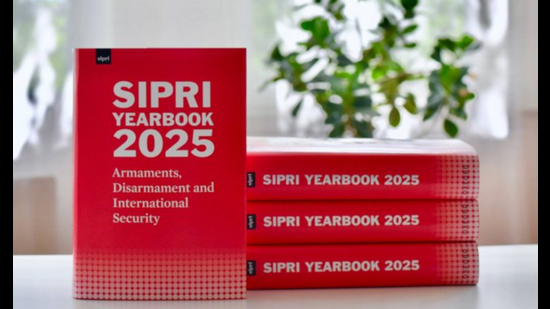India has more nuclear weapons than Pakistan, but Beijing’s strategic arsenal is bigger than New Delhi’s, said the Stockholm International Peace Research Institute (SIPRI) in a new yearbook released on Monday.
 SIPRI revises its world nuclear forces data every year based on new information. (X)
SIPRI revises its world nuclear forces data every year based on new information. (X)
SIPRI pegged the number of nuclear warheads in the Indian arsenal at 180 as of January 2025, compared to 172 a year earlier, while Pakistan is estimated to have 170 nuclear weapons, the same as last year. China’s arsenal consisted of 600 nuclear warheads in January 2025, up from 500 last year.
SIPRI revises its world nuclear forces data every year based on new information. Its latest report comes after India launched Operation Sindoor in the early hours of May 7 and struck terror and military installations in Pakistan and Pakistan-occupied Kashmir (PoK) following the Pahalgam terror strike in which 26 people were shot dead. The strikes triggered a four-day military confrontation with Pakistan involving fighter jets, missiles, drones, long-range weapons, and heavy artillery.
The SIPRI report said Russia and the US have the biggest arsenals among the nine nuclear-armed states (5,459 and 5,177). It added that although Pakistan remains the focus of India’s nuclear deterrent, India appears to be placing growing emphasis on longer-range weapons capable of reaching targets throughout China.
India last year commissioned its second indigenous nuclear-powered ballistic missile submarine, INS Arighaat, at Visakhapatnam in a step towards strengthening the country’s nuclear triad (ability to launch strategic weapons from land, sea, and air).
India’s nuclear weapons, the SIPRI report said, were assigned to a maturing nuclear triad of aircraft, land-based missiles, and SSBNs (ship submersible ballistic nuclear or nuclear-powered ballistic missile submarines).
“It has long been assumed that India stores its nuclear warheads separate from its deployed launchers during peacetime; however, the country’s recent moves towards placing missiles in canisters and conducting sea-based deterrence patrols suggest that India could be shifting in the direction of mating some of its warheads with their launchers in peacetime,” the report said. India is building a fleet of four to six SSBNs as it continues to develop the naval component of its nascent nuclear triad, it said.
The country’s third nuclear-powered ballistic missile submarine, Aridaman or S-4, is set to be commissioned later this year, followed by a fourth SSBN codenamed S-4*. Arighaat or S-3 is the second Arihant-class submarine and more advanced than INS Arihant (S-2).
The US, Russia, the United Kingdom, France, and China are the only other countries that can deliver nuclear warheads from a submarine.
China is in the middle of a significant modernisation and expansion of its nuclear arsenal, SIPRI said. “Depending on how it decides to structure its forces, China could potentially have at least as many ICBMs (inter-continental ballistic missiles) as either Russia or the US by the turn of the decade, although its stockpile of nuclear warheads is still expected to remain much smaller than the stockpiles of either of those two countries.”
The rise in the number of states with multiple-warhead programmes could potentially lead to a rapid increase in deployed warheads and allow nuclear-armed states to threaten the destruction of significantly more targets, especially in the case of China, which has the fastest-growing nuclear arsenal in the world, the report said.
India has developed the Agni-5 missile with multiple independently targetable reentry vehicle (MIRV) technology. The MIRV capability allows the weapon system to deliver multiple nuclear warheads against different targets spread across hundreds of kilometres. MIRVs can cause more destruction than traditional missiles that carry a single warhead.
India’s nuclear doctrine, promulgated in 2003, commits the country to a “no first use” posture, with weapons to be used only in retaliation against a nuclear attack on Indian territory or Indian forces. It states that nuclear retaliation to a first strike will be massive and designed to inflict unacceptable damage.
Under India’s doctrine, retaliatory attacks can only be authorised by the civilian political leadership through the Nuclear Command Authority, consisting of a political council and executive council. The prime minister chairs the political council, while the national security advisor chairs the executive council.
